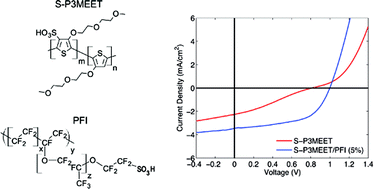High work-function hole transport layers by self-assembly using a fluorinated additive†
Abstract
The hole transport polymer poly(3,4-ethylenedioxythiophene):poly(4-styrenesulfonate) (PEDOT:PSS) derives many of its favorable properties from a PSS-rich interfacial layer that forms spontaneously during coating. Since PEDOT:PSS is only usable as a blend it is not possible to study PEDOT:PSS without this interfacial layer. Through the use of the self-doped polymer sulfonated poly(thiophene-3-[2-(2-methoxyethoxy) ethoxy]-2,5-diyl) (S-P3MEET) and a polyfluorinated ionomer (PFI) it is possible to compare transparent conducting organic films with and without interfacial layers and to understand their function. Using neutron reflectometry, we show that PFI preferentially segregates at the top surface of the film during coating and forms a thermally-stable surface layer. Because of this distribution we find that even small amounts of PFI increase the electron work function of the hole transport layer. We also find that annealing at 150 °C and above reduces the work function compared to samples heated at lower temperatures. Using near edge X-ray absorption fine structure spectroscopy and gas chromatography we show that this reduction in work function is due to S-P3MEET being doped by PFI. Organic photovoltaic devices with S-P3MEET/PFI hole transport layers yield higher power conversion efficiency than devices with pure S-P3MEET or PEDOT:PSS hole transport layers. Additionally, devices with a doped interface layer of S-P3MEET/PFI show superior performance to those with un-doped S-P3MEET.


 Please wait while we load your content...
Please wait while we load your content...